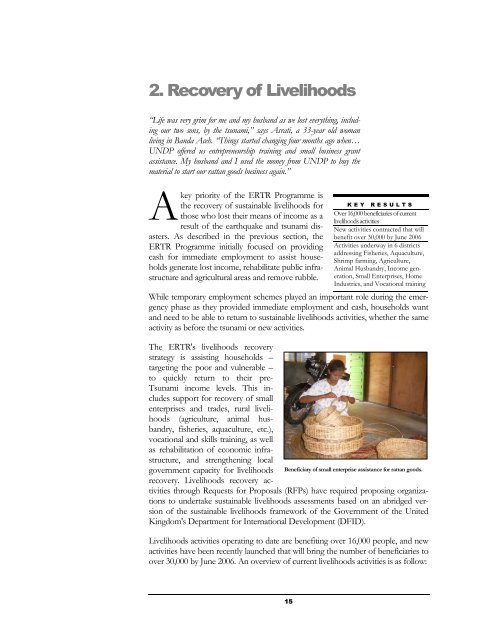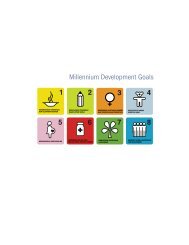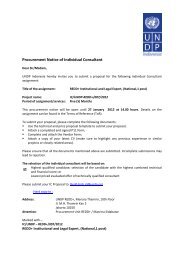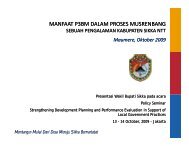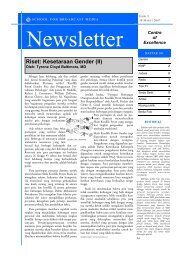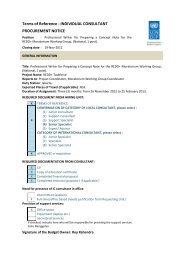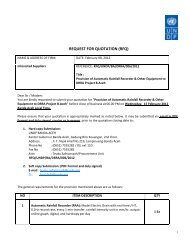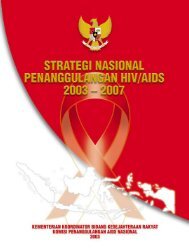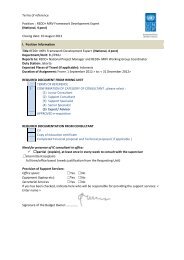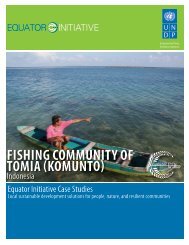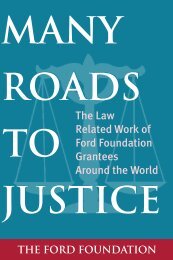Aceh Emergency Response and Transitional Recovery ... - UNDP
Aceh Emergency Response and Transitional Recovery ... - UNDP
Aceh Emergency Response and Transitional Recovery ... - UNDP
Create successful ePaper yourself
Turn your PDF publications into a flip-book with our unique Google optimized e-Paper software.
2. <strong>Recovery</strong> of Livelihoods“Life was very grim for me <strong>and</strong> my husb<strong>and</strong> as we lost everything, includingour two sons, by the tsunami,” says Asrati, a 33-year old womanliving in B<strong>and</strong>a <strong>Aceh</strong>. “Things started changing four months ago when…<strong>UNDP</strong> offered us entrepreneurship training <strong>and</strong> small business grantassistance. My husb<strong>and</strong> <strong>and</strong> I used the money from <strong>UNDP</strong> to buy thematerial to start our rattan goods business again.”Akey priority of the ERTR Programme isthe recovery of sustainable livelihoods forthose who lost their means of income as aresult of the earthquake <strong>and</strong> tsunami disasters.As described in the previous section, theERTR Programme initially focused on providingcash for immediate employment to assist householdsgenerate lost income, rehabilitate public infrastructure<strong>and</strong> agricultural areas <strong>and</strong> remove rubble.KEY RESULTSOver 16,000 beneficiaries of currentlivelihoods activitiesNew activities contracted that willbenefit over 30,000 by June 2006Activities underway in 6 districtsaddressing Fisheries, Aquaculture,Shrimp farming, Agriculture,Animal Husb<strong>and</strong>ry, Income generation,Small Enterprises, HomeIndustries, <strong>and</strong> Vocational trainingWhile temporary employment schemes played an important role during the emergencyphase as they provided immediate employment <strong>and</strong> cash, households want<strong>and</strong> need to be able to return to sustainable livelihoods activities, whether the sameactivity as before the tsunami or new activities.The ERTR's livelihoods recoverystrategy is assisting households –targeting the poor <strong>and</strong> vulnerable –to quickly return to their pre-Tsunami income levels. This includessupport for recovery of smallenterprises <strong>and</strong> trades, rural livelihoods(agriculture, animal husb<strong>and</strong>ry,fisheries, aquaculture, etc.),vocational <strong>and</strong> skills training, as wellas rehabilitation of economic infrastructure,<strong>and</strong> strengthening localgovernment capacity for livelihoods Beneficiary of small enterprise assistance for rattan goods.recovery. Livelihoods recovery activitiesthrough Requests for Proposals (RFPs) have required proposing organizationsto undertake sustainable livelihoods assessments based on an abridged versionof the sustainable livelihoods framework of the Government of the UnitedKingdom's Department for International Development (DFID).Livelihoods activities operating to date are benefiting over 16,000 people, <strong>and</strong> newactivities have been recently launched that will bring the number of beneficiaries toover 30,000 by June 2006. An overview of current livelihoods activities is as follow:15


